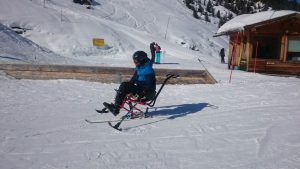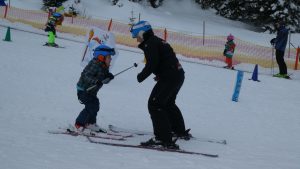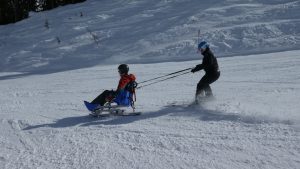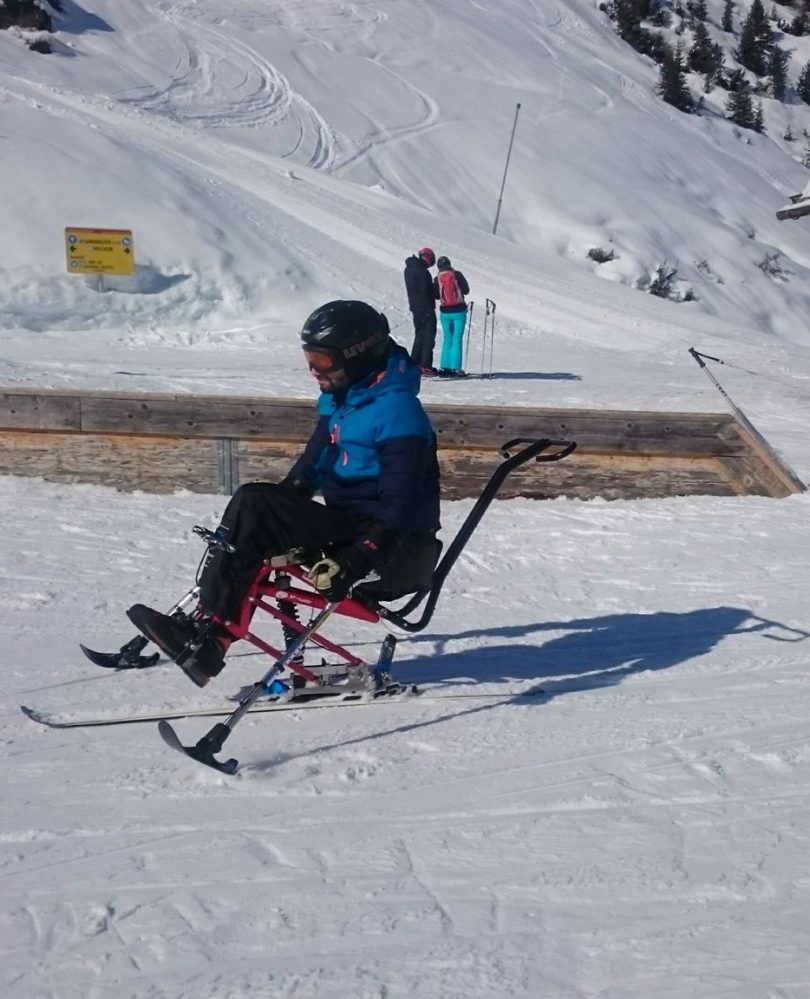What is adaptive skiing?
To the adaptive sports world it is self explanatory. For those of you reading this who haven’t heard the term before, adaptive skiing refers to skiing for people with disabilities with or without specialised equipment. However, in reality when adaptive skiing is mentioned people mostly talk about sitskis and wheelchair users.
 So, is adaptive skiing only sitskis?
So, is adaptive skiing only sitskis?
Sitskis are noticeable but are not the whole story.
Generally, when people think of disability they think of wheelchair users because that is what stands out. Actually, wheelchair users are a small percentage of the disabled population.
According to Disability Sport, less than 8% of disabilities require the use of a wheelchair of whom only around 30% are under the age of 60.
These percentages are reflected in the adaptive skiing world. There are many ski students who don’t use special equipment but benefit massively from having an instructor with an adaptive mindset and an adaptive approach.
Adaptive mindset or adaptive approach? But what does “adaptive” mean?
The Oxford Dictionary says “adaptive” is concerned with changing; able to change when necessary in order to deal with different situations.
So how does that relate to skiing?
All ski instructor associations have some kind of system for teaching a beginner progression. These systems are designed to take a “never, ever” skier from beginner to a competent, confident skier.
If an instructor rigidly follows one of these progression pathways they can be more or less successful depending on a number of factors, including ability, fitness, sportiness, understanding, snow conditions, terrain… amongst others.
From an adaptive ski teaching point of view, The Irish Association of Snowsports Instructors are an interesting association to look at in this respect. They realise that there are several different ways to achieve the same outcome. In their instructors, they are looking for “skillful, rounded skiers who are adaptable on all terrain.”  With their “Learn it, Love it, Live it” philosophy they want instructors to be interested in learning and passing it on, passionate about the sport to fire up enthusiasm in their students, open-minded, looking at different methods and ideas so that improvement and development, as a teacher and as a skier, become a way of life.
With their “Learn it, Love it, Live it” philosophy they want instructors to be interested in learning and passing it on, passionate about the sport to fire up enthusiasm in their students, open-minded, looking at different methods and ideas so that improvement and development, as a teacher and as a skier, become a way of life.
Good ski teachers are also good adaptive ski instructors. The key quality necessary is to have an adaptive mindset. For example, if a student has difficulty understanding, explain/describe in a different way. If the terrain is not suitable, go to a different piste. If a person struggles to make a snowplough, skip the snowplough stage and teach them to ski parallel.
An instructor with an adaptive mindset will decide on an outcome and then adjust inputs to achieve the required result.
“Adaptive skiing” is an extension of this.
We choose a desired outcome and then look at what is necessary to achieve it. The “adaptions” can often be more complicated than in a “standard” ski school lesson, we may not only need a change of vocabulary, but also a change of equipment. Sometimes, we need to use a sitski or outriggers, or one boot bigger than the other. We may need to use a radio to guide a visually impaired skier. What is important is that we look at what a skier has and what they can do and make adaptions accordingly.
 Sometimes the approach to adaptive skiing is the other way around. People concentrate on the equipment… To be fair, there is a lot of cool and useful equipment available which can be distracting. However, looking at skiing with an adaptive mindset is the key, whether with regards to equipment, terrain, snow and weather conditions, or even attitude.
Sometimes the approach to adaptive skiing is the other way around. People concentrate on the equipment… To be fair, there is a lot of cool and useful equipment available which can be distracting. However, looking at skiing with an adaptive mindset is the key, whether with regards to equipment, terrain, snow and weather conditions, or even attitude.
So, if the answer to adaptive ski teaching is simply to have an adaptive mindset – why should I have an adaptive ski teaching qualification?
Whilst being open and willing to change and “adapt” is important, attending an adaptive ski teaching course can also be beneficial. You will learn about what equipment is available, how it can be used and for which specific set of circumstances it works best. There will be emphasis on disability awareness, including typical characteristics and so called “Red Flags” which help us, as instructors, to keep the student safe and comfortable. And thirdly you will start to build your own “toolbox” of tips and tricks that will contribute to your ability to adapt and support your “adaptive mindset”.
And, to finish, a word of warning… once you start to open your mind to the idea that there are many different ways to achieve the same outcome you will gradually start to realise that actually most ski lessons that you teach are actually adaptive lessons, one way or another!

